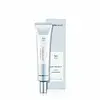Colourette First Base Everyday Skin Tint SPF 30 Versus Thank You Farmer Sun Project Light Sun Essence SPF50+ PA+++
What's inside
What's inside
 Key Ingredients
Key Ingredients

 Benefits
Benefits

 Concerns
Concerns

 Ingredients Side-by-side
Ingredients Side-by-side

Water
Skin ConditioningCyclopentasiloxane
EmollientIsotridecyl Isononanoate
EmollientDimethicone
EmollientButylene Glycol
HumectantSilica
AbrasiveTitanium Dioxide
Cosmetic ColorantPentaerythrityl Tetraethylhexanoate
EmollientGlycerin
HumectantTrimethylsiloxysilicate
EmollientPEG-10 Dimethicone
Skin ConditioningCetyl PEG/PPG-10/1 Dimethicone
EmulsifyingDisteardimonium Hectorite
StabilisingSodium Chloride
MaskingCaprylyl Glycol
EmollientPhenoxyethanol
PreservativeHexylene Glycol
EmulsifyingNiacinamide
SmoothingPotassium Azeloyl Diglycinate
Skin ConditioningSodium Hyaluronate
HumectantCI 77891
Cosmetic ColorantCI 77492
Cosmetic ColorantCI 77491
Cosmetic ColorantCI 77499
Cosmetic ColorantWater, Cyclopentasiloxane, Isotridecyl Isononanoate, Dimethicone, Butylene Glycol, Silica, Titanium Dioxide, Pentaerythrityl Tetraethylhexanoate, Glycerin, Trimethylsiloxysilicate, PEG-10 Dimethicone, Cetyl PEG/PPG-10/1 Dimethicone, Disteardimonium Hectorite, Sodium Chloride, Caprylyl Glycol, Phenoxyethanol, Hexylene Glycol, Niacinamide, Potassium Azeloyl Diglycinate, Sodium Hyaluronate, CI 77891, CI 77492, CI 77491, CI 77499
Water
Skin ConditioningEthylhexyl Methoxycinnamate
UV AbsorberHomosalate
Skin ConditioningEthylhexyl Salicylate
UV AbsorberDiethylamino Hydroxybenzoyl Hexyl Benzoate
UV FilterButylene Glycol
HumectantOctocrylene
UV AbsorberDicaprylyl Carbonate
EmollientCyclopentasiloxane
EmollientC20-22 Alkyl Phosphate
EmulsifyingC20-22 Alcohols
Emulsion StabilisingSilica
Abrasive1,2-Hexanediol
Skin ConditioningPortulaca Oleracea Extract
Skin ConditioningNelumbo Nucifera Flower Water
TonicGlycine Soja Lipids
Skin ConditioningEchium Plantagineum Seed Oil
Skin ConditioningAloe Barbadensis Leaf Extract
EmollientAlthaea Rosea Flower Extract
Skin ConditioningCardiospermum Halicacabum Flower/Leaf/Vine Extract
Skin ConditioningHelianthus Annuus Seed Oil Unsaponifiables
EmollientPlukenetia Volubilis Seed Oil
EmollientCetyl Alcohol
EmollientGlyceryl Stearate
EmollientGlycerin
HumectantTromethamine
BufferingPolyacrylate Crosspolymer-6
Emulsion StabilisingOctyldodecanol
EmollientGlyceryl Caprylate
EmollientCaprylyl Glycol
EmollientMicrocrystalline Cellulose
AbsorbentXanthan Gum
EmulsifyingSodium Acrylate/Sodium Acryloyldimethyl Taurate Copolymer
Emulsion StabilisingPolyisobutene
Ethylhexylglycerin
Skin ConditioningGlyceryl Polymethacrylate
Cellulose Gum
Emulsion StabilisingSorbitan Oleate
EmulsifyingCaprylyl/Capryl Glucoside
CleansingParfum
MaskingWater, Ethylhexyl Methoxycinnamate, Homosalate, Ethylhexyl Salicylate, Diethylamino Hydroxybenzoyl Hexyl Benzoate, Butylene Glycol, Octocrylene, Dicaprylyl Carbonate, Cyclopentasiloxane, C20-22 Alkyl Phosphate, C20-22 Alcohols, Silica, 1,2-Hexanediol, Portulaca Oleracea Extract, Nelumbo Nucifera Flower Water, Glycine Soja Lipids, Echium Plantagineum Seed Oil, Aloe Barbadensis Leaf Extract, Althaea Rosea Flower Extract, Cardiospermum Halicacabum Flower/Leaf/Vine Extract, Helianthus Annuus Seed Oil Unsaponifiables, Plukenetia Volubilis Seed Oil, Cetyl Alcohol, Glyceryl Stearate, Glycerin, Tromethamine, Polyacrylate Crosspolymer-6, Octyldodecanol, Glyceryl Caprylate, Caprylyl Glycol, Microcrystalline Cellulose, Xanthan Gum, Sodium Acrylate/Sodium Acryloyldimethyl Taurate Copolymer, Polyisobutene, Ethylhexylglycerin, Glyceryl Polymethacrylate, Cellulose Gum, Sorbitan Oleate, Caprylyl/Capryl Glucoside, Parfum
 Reviews
Reviews

Ingredients Explained
These ingredients are found in both products.
Ingredients higher up in an ingredient list are typically present in a larger amount.
Butylene Glycol (or BG) is used within cosmetic products for a few different reasons:
Overall, Butylene Glycol is a safe and well-rounded ingredient that works well with other ingredients.
Though this ingredient works well with most skin types, some people with sensitive skin may experience a reaction such as allergic rashes, closed comedones, or itchiness.
Learn more about Butylene GlycolCaprylyl Glycol is a humectant and emollient, meaning it attracts and preserves moisture.
It is a common ingredient in many products, especially those designed to hydrate skin. The primary benefits are retaining moisture, skin softening, and promoting a healthy skin barrier.
Though Caprylyl Glycol is an alcohol derived from fatty acids, it is not the kind that can dry out skin.
This ingredient is also used as a preservative to extend the life of products. It has slight antimicrobial properties.
Learn more about Caprylyl GlycolCyclopentasiloxane, or D5, is a silicone used to improve texture of products and trap moisture.
D5 is considered lightweight and volatile. Volatile means it evaporates quickly after application. Once evaporated, D5 leaves a thin barrier that helps keep skin hydrated.
It is also an emollient. Emollients help soften the skin and prevent water loss. Silicones create a silky texture in products. D5 helps other ingredients become more spreadable.
Studies show D5 is safe to use in skincare products. We recommend speaking with a skincare professional if you have concerns.
Learn more about CyclopentasiloxaneGlycerin is already naturally found in your skin. It helps moisturize and protect your skin.
A study from 2016 found glycerin to be more effective as a humectant than AHAs and hyaluronic acid.
As a humectant, it helps the skin stay hydrated by pulling moisture to your skin. The low molecular weight of glycerin allows it to pull moisture into the deeper layers of your skin.
Hydrated skin improves your skin barrier; Your skin barrier helps protect against irritants and bacteria.
Glycerin has also been found to have antimicrobial and antiviral properties. Due to these properties, glycerin is often used in wound and burn treatments.
In cosmetics, glycerin is usually derived from plants such as soybean or palm. However, it can also be sourced from animals, such as tallow or animal fat.
This ingredient is organic, colorless, odorless, and non-toxic.
Glycerin is the name for this ingredient in American English. British English uses Glycerol/Glycerine.
Learn more about GlycerinSilica, also known as silicon dioxide, is a naturally occurring mineral. It is used as a fine, spherical, and porous powder in cosmetics.
Though it has exfoliant properties, the function of silica varies depending on the product.
The unique structure of silica enhances the spreadability and adds smoothness, making it a great texture enhancer.
It is also used as an active carrier, emulsifier, and mattifier due to its ability to absorb excess oil.
In some products, tiny microneedles called spicules are made from silica or hydrolyzed sponge. When you rub them in, they lightly polish away dead skin layers and enhance the penetration of active ingredients.
Learn more about SilicaWater. It's the most common cosmetic ingredient of all. You'll usually see it at the top of ingredient lists, meaning that it makes up the largest part of the product.
So why is it so popular? Water most often acts as a solvent - this means that it helps dissolve other ingredients into the formulation.
You'll also recognize water as that liquid we all need to stay alive. If you see this, drink a glass of water. Stay hydrated!
Learn more about Water